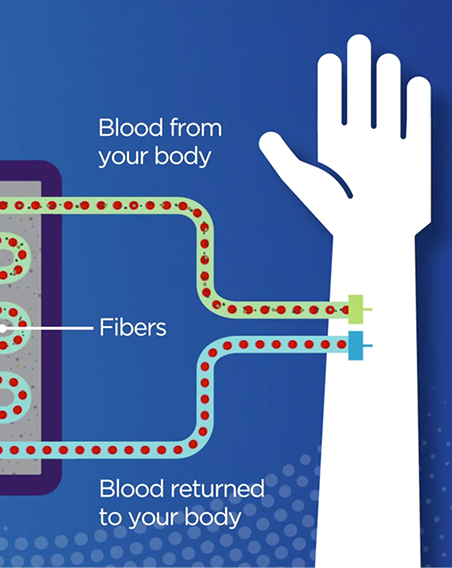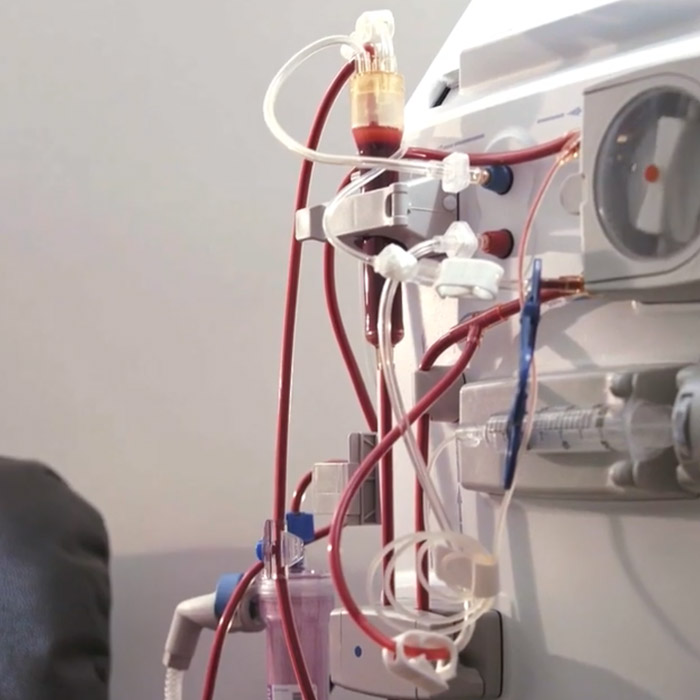What is hemodialysis (HD)?
The word “hemo” refers to blood. HD filters your blood outside your body using a machine and a manufactured filter, called a dialyzer. This dialyzer acts as an artificial kidney. The HD machine makes the dialysis solution that is delivered to the dialyzer. The combination of dialysis solution, dialyzer, and machine functions to remove excess water and waste from your blood.
During HD, a machine removes blood from your body using a needle or a central venous catheter. Your blood is then pumped through the dialyzer, where it meets the dialysis solution that the machine produced. It is at this point where the blood is cleaned, and fluid is pulled across the dialyzer from the patient and into the machine. The blood exiting the dialyzer that has been cleaned is returned to your body through a second needle or a second branch of catheter.
Hemodialysis is usually performed during a scheduled time at the hospital or in a dialysis clinic and is referred to as in-center HD. Most people require HD 3 times a week, with each treatment session lasting about 4 hours, depending on the dialysis prescription the doctor has recommended.
Please click here if you would like to read more detailed information about different types of dialysis and different ways of doing dialysis.

What is home HD?
HD is a type of dialysis that filters your blood outside your body using a machine and a dialyzer, which is a manufactured filter that acts like an artificial kidney. Home HD is done in your home after extensive training is complete.

Home HD can give you more freedom
Home HD provides more flexibility than in-center HD, allowing people to plan treatments around the activities they know and love. It may even be possible to travel while on home HD. You should speak with your clinician before planning activities and trips, as they can give you more information on how to stay safe and healthy while pursuing a full and active life.
Before you begin home HD, you and your caregiver will need to get trained. You will need to complete the 4–6 weeks of training required to perform treatment safely and successfully.

Preparing your home for home HD
To perform safe and effective home HD, a dedicated clean area is needed. Also required are a comfortable chair or bed and a telephone with which you can make any necessary calls to your healthcare team. The treatment area will need to be adapted for dialysis with the type of electrical outlet needed for your dialysis machine, a water source that can be accessed easily during treatment, and a plumbing system for draining away any waste water. These adjustments will be organized by your clinic or hospital.
A member of your healthcare team will visit you at home and help you decide on the best place to set up your treatment area and store your supplies.

Benefits of home HD
Home HD may be the right treatment option for you if it is well suited to your medical and physical condition and your lifestyle choices. Home HD gives you the opportunity to enjoy the comfort and freedom that come with performing dialysis in a space that feels familiar and safe, while having telephone access to professional help if you need it. Doing your treatments at home may also increase your flexibility by allowing you to avoid frequent trips to the hospital or clinic.
You will have some control over your treatment, choosing a schedule that fits your social and professional life. If your clinician prescribes it, you may be allowed to do dialysis more frequently and for longer periods of time than with conventional in-center HD. If you can, having longer, slower treatments more often may be gentler on your body because it more closely mimics your natural kidney function, which works 24 hours per day. This may decrease negative side effects and help you feel better and more energized, and even give you more dietary freedom.
In addition to the benefits of home HD, you should be aware of some of the special considerations of this treatment. For example:
- Needles must be inserted during each treatment, which may be uncomfortable for you if you are afraid of needles.
- Almost all home HD patients require the help of a caregiver.
- Your treatments will be performed away from your healthcare team.
- You will need to store up to 6 weeks’ worth of dialysis equipment and supplies in your home.
All these benefits and considerations should be discussed with your clinician so that you can make a decision that suits your medical and lifestyle needs.

What is in-center HD?
HD is a type of dialysis that filters your blood outside your body using a machine and a dialyzer, which is a manufactured filter that acts like an artificial kidney. In-center HD is done in either a hospital or a dialysis clinic, with nurses and/or technicians doing the procedure for patients.
How does in-center HD work?
If you are treated with in-center HD, you will typically travel to your hospital or dialysis clinic 3 times a week to receive a 3- to 5-hour treatment each time, depending on the dialysis schedule your clinician has prescribed. There, you will be taken care of by a nurse or clinician throughout your treatment.
Before each in-center HD treatment, a member of your care team will give you a short physical examination and weigh you to determine how much fluid needs to be removed from your body. Your treatment access site will be cleaned, the needles required for treatment will be inserted, and the tubing that connects your access site to the HD machine will be set up. Your HD treatment will then begin, and you will be looked after by a nurse or technician. When your treatment is done and you’ve been disconnected from the machine, your blood pressure will be measured and you can leave the center.
It is a good idea to arrive early for your in-center HD appointments to allow enough time for your healthcare team’s preparation. Wear comfortable clothing. Bring a book or another form of entertainment. During and after your HD treatments, you may feel tired or experience uncomfortable leg cramps or nausea. Thus, it is common to want to go home and rest. If you experience unusual symptoms during or after your treatment, talk to your clinical team about your symptoms.
In terms of how the therapy feels, you should expect to feel some mild pain during the needle insertion phase, and as mentioned before, you may feel tired or experience uncomfortable leg cramps or nausea after therapy. The therapy itself should not be painful.
Preparing for in-center HD
Before in-center HD treatments start, you may also need to have a surgical procedure that creates a dialysis access site under your skin called a fistula. Once two needles are inserted in the fistula and blood tubing is attached, unfiltered blood flows from your blood vessels to the HD machine and dialyzer, and then the clean blood flows back into your blood vessels.
There are 3 different types of HD access: fistula, graft, and HD catheter. Each has its own benefits and drawbacks, and you should discuss these with your care team to determine which will be the safest and most effective access option for you. Typically, a fistula is considered the best option where possible.
No matter which kind of access type you choose, you’ll have to protect your access site from excess pressure, germs, and infection. Remember to clean your hands before touching your access site and consistently check it for signs of swelling and irritation. If you suspect these issues, contact your nurse immediately. This is true for all dialysis treatment options.
Benefits of in-center HD
In-center HD is performed under the supervision of a supportive clinical team, meaning that you can let others take care of you during treatment. You can use your treatment time to sleep, read, work on your laptop, listen to music, or do something else you enjoy. You will also have the opportunity to talk to other dialysis patients.
There may be other benefits to receiving in-center HD. For example, it might be favorable for you to receive treatment outside your home. It gives you the opportunity to get out of the house, may be less invasive for your family, and may help you keep your dialysis life separate from your home life.
While in-center HD has certain benefits, it also has special considerations. You should consider the following before speaking with your clinician about whether in-center HD is right for you:
- If you live far from your dialysis clinic, you may need to build transportation time into your treatment schedule 3 times per week.
- If you require hospital-/clinic-provided transport to get to your appointments, they may pick you and other patients up early, and you may have to wait for transport after dialysis to return home.
- Depending on your access, needles must be inserted during each treatment, which may be uncomfortable for you if you are afraid of needles.
- During and after your HD treatments, you may feel tired or nauseated.
- It may be difficult to plan your daily schedule around your treatment sessions.
FAQs about HD
Already considering PD? Explore PD and how it works
PD may be the right treatment for you if you work, study, or travel regularly and if it suits your lifestyle and medical and physical condition.


